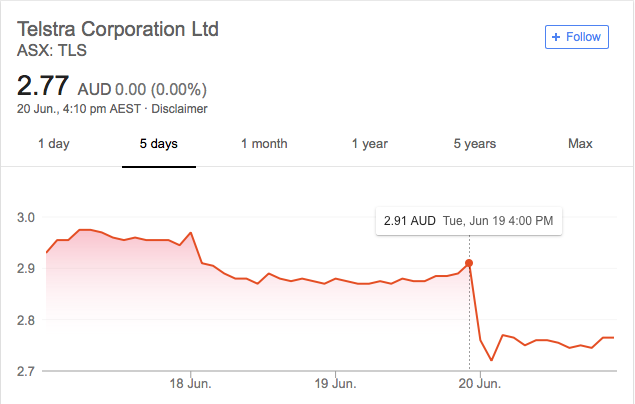If HR is advising leaders, it needs to know how shareholders think. HRM looks at Telstra’s recent announcement of redundancies as a case study.
Marketing a mass redundancy is never an easy thing, as HRM’s look at the NAB announcement demonstrated. There are many distinct stakeholders, all of which you’re looking to please – or at least reassure – simultaneously.
But what if during that redundancy announcement you were also negotiating an enterprise bargaining agreement, changing your business strategy, unveiling a company split and revealing surprisingly low revenue? This is what Telstra went through this week with its headline-making job cuts.
Upon CEO Andy Penn’s announcement on Wednesday Telstra shares took a hit. Having HR frame people strategy is something CEOs want when they’re talking to shareholders. So it’s worth taking a look at Telstra’s plan, and its messaging.

Guess when the Telstra announcement happened. Source: Google
Digitisation and job cuts
“Cold-blooded investors usually like a good cost-cull in a mature business, as it promises more dollars drop to the bottom line and hopefully into their pockets,” writes Patrick Commins in an Australian Financial Review article about the Telstra strategy announcement. Cutting 8,000 employees including two to four layers of management is quite a cost-cull, so why didn’t investors respond well?
Beyond the job cuts, Telstra announced that it would be also simplifying things for its customers by reducing its 1,800 plans to 20 within three years, and by upgrading its technology so that users can make changes to their products quickly. The hope is that this will reduce the need for customer service (and the staff who provide it). Union spokespeople, and at least one financial analyst, believe it will also reduce the quality of customer service.
Penn described the people strategy behind the move this way: “In the future, our workforce will be a smaller, knowledge-based one with a structure and way of working that is agile enough to deal with rapid change. This means that some roles will no longer be required, some will change and there will also be new ones created.”
Or, to put it another way, “digitisation”. Which makes sense; there’s an HR joke that says digitisation is just another word for layoffs.
But the problem for Telstra is found in the premise of another business joke, one I heard at a conference this year. “Everything in this shifting landscape accelerates, except large companies”.
The theory that Telstra’s efforts to disrupt itself are correct, but have come too late for many investors, is seemingly backed by its own results. The company had already announced they would be underperforming on revenues this year. But this week announced they would be underperforming going forward in 2019 (they expect to be up to $3 billion below analysts’ consensus).
(If you were advising a CEO with their shareholder messaging, what would you say? Is there anything HR can do when the business changes are this large? Let us know in the comments.)
Managing the managers
The important stakeholder for HR is the workforce, including those who will be leaving, those who will be staying, and those arriving (the company announced a plan to hire more tech workers). Making it hard for HR at Telstra is that many of the cuts are aimed at management – one in four executive and middle management roles are expected to go.
As author of Conversations of Change and expert in organisational change Dr Jen Frahm says of the situation, “Managers are expected to manage anxious and stressed teams at the same time as managing their own emotional reaction and concern for job security”.
She offered the following tips to HR and managers:
- Engage with resistance – don’t seek to overcome. Resistance is normal, highly complex, and only feedback.
- Don’t forget to communicate what stays the same. People need an anchor in stormy seas, and a simple message of what is not changing can do that.
- Dignity is the key word – your role as people leader is to interrogate every message to ensure that there is as much dignity as possible. Respect yourself, respect your managers, respect your employees, respect your customers, respect your community.
- Engage with the background talk. This is the informal conversations of change that can manifest in gossip, rumour, and hallway chats. Engaging with the rumours allows clarification of incorrect information and guided sense-making. You can also get some very useful feedback.
Frahm also mentions that you should look after yourself, and be practical. “Recognising your emotional state is completely valid – you need to lean into that, acknowledge and respect that.”
Taking time to tend to your network and thinking about your current role and your career is also important, she says.
Photo credit: Indigo Skies Photography (slight modifications to original photo have been made)


All change processes require a ‘start point’ a reason for change, in Telstra’s case an Urgency to Change. Building on that the CEO needs a competent team to lead the change process, determine process and timing. This would include all stakeholder groups, including employees and shareholders. Telstra (Telecom Australia) back in 1992 had 110,000 employees. In 2003 they had 40,000 employees. Still the same number of customers and traffic on their network. Unfortunately during that time they were a company of numbers first and then think about how to achieve the numbers without diminishing service. That is until they started… Read more »